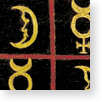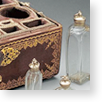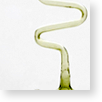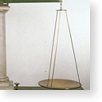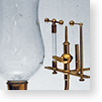Starting in the second half of the 15th century, the Medici Court attracted many alchemists to Florence, providing them with avant-garde factories and laboratories. Of the immense Medicean collection of alchemists' instrumentation, very little has survived: only a few glass vessels used by the Accademia del Cimento (1657-1667), and the great burning lens donated by Benedetto Bregans in 1697 to Cosimo III (1642-1723) to experiment with the combustion of gemstones, displayed here on the stand at the centre of the room. On the wall behind it hangs the "table of chemical affinities", emblematic testimony to the Lorraine dynasty's interest in pharmaceutical chemistry. The numerous instruments used in theoretical and experimental chemistry also come from the Lorraine collection. Atmospheric chemistry especially, with the discovery of hydrogen and a method for determining the amounts of oxygen and other gases present in the atmosphere, favoured the development of new measuring instruments, such as Alessandro Volta's (1745-1827) electric pistol and hydrogen lamp, Felice Fontana's (1730-1805) evaerometro, and Marsilio Landriani's (1751-1815) eudiometer.
Chemical "Affinities"
In 1718 Étienne-François Geoffroy (1672-1731) presented in Paris a "table of affinities" that, by adapting Isaac Newton's (1642-1727) laws of attraction ...
(2 objects)
From Philosophy to Pharmacy
Plato supposed that matter was formed of particles shaped like regular solids. This hypothesis seemed confirmed, in the first half of the 17th century, ...
(11 objects)
Mastering Fire
The greatest progress in modern chemistry was attained by perfecting instrumentation able to control fire, the chief element used by chemists to analyze ...
(21 objects)
Quantitative Chemistry
In the second half of the 18th century chemists felt the need for greater precision in their experimentation. New, sophisticated scales with hitherto unimaginably ...
(10 objects)
Understanding Air
The tendency to quantify chemical phenomena reached its apex near the end of the 18th century, when it was discovered that atmospheric air was not a simple ...










